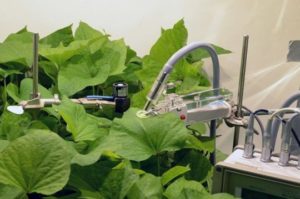Source: sciencedaily.com
Published: May 9, 2016
System helps lights adapt to plants’ needs in controlled environment agriculture
Source: American Society for Horticultural Science
Summary:
A chlorophyll fluorescence-based biofeedback system was used to maintain the electron transport rate (a proxy for photosynthesis) of lettuce, sweetpotato, and pothos at target rates altered over 15 hours. The biofeedback system can maintain a wide range of ETRs by automatically adjusting light output from LEDs. It can also distinguish between standard plant mechanisms to dissipate excess light energy and damage to the photosynthetic apparatus as causes for decreases in light use efficiency of plants.
Controlled environment agriculture is rapidly becoming an important part of the global food system. For example, there has been much interest in the potential of large-scale, indoor agricultural production – often referred to as vertical farming – as a means to produce high quantities of produce. These “plant factories” are expensive to operate, however, in part because of the large power requirements of electric lamps that provide the type and amount of light necessary for photosynthesis in plants.
To find new methods of adapting lighting to plants’ requirements in controlled environments such as vertical farms, the researchers developed and tested a biofeedback system that allows for the control of light levels based on the physiological performance of the plants. “Controlling the intensity of light based on plants’ ability to use it efficiently may substantially reduce the energy cost of LED lighting, and contribute to making large-scale controlled environment agriculture more profitable,” van Iersel said.
The researchers used lettuce, pothos, and sweetpotato plants in experiments with photosynthetic light provided by a 400-Watt LED. Using chlorophyll fluorescence measurements, a datalogger determined how efficiently the plants used the light they received. This data was used to calculate the electron transport rate (ETR), which is an indicator of photosynthesis. The datalogger then altered the duty cycle (the proportion of time that the LEDs are energized during each short on/off cycle) of the LEDs to provide more or less light.
The target ETR was altered in a stepwise pattern over a 15-h period. The biofeedback system was capable of automatically adjusting the light levels to assure that the desired ETR was reached. As the target ETR was increased, light levels increased as well. In addition, conversion of light energy into heat (a common way for plants to deal with excess light) was upregulated, while the light use efficiency decreased. As the target ETR was decreased during the last 7 hours, conversion of light into heat decreased greatly in lettuce and pothos, with only a small increase in light use efficiency. “This suggests that the light use efficiency of lettuce and pothos was limited by a process other than conversion into heat, likely light-induced damage to the photosynthetic machinery in the leaves,” the authors noted.
“The biofeedback system successfully maintained a wide range of ETR values in different species, while it also is capable of distinguishing between conversion of light into heat and damage to the photosynthetic machinery as causes for decreases in light use efficiency,” the authors said. They said the biofeedback system has potential applications in controlled environment agriculture, as well as basic plant physiology studies, where the system can be used to maintain specific levels of physiological activity.
Story Source:
Materials provided by American Society for Horticultural Science. Note: Content may be edited for style and length.
Journal Reference:
- Marc W. van Iersel, Geoffrey Weaver, Michael T. Martin, Rhuanito S. Ferrarezi, Erico Mattos, and Mark Haidekker. A Chlorophyll Fluorescence-based Biofeedback System to Control Photosynthetic Lighting in Controlled Environment Agriculture. J. Amer. Soc. Hort. Sci, 141:169-176

